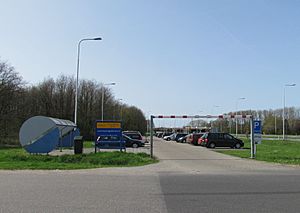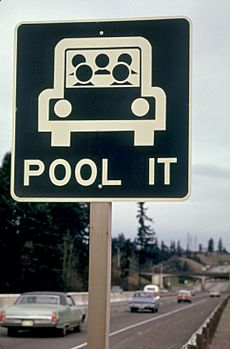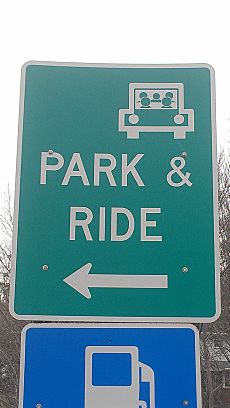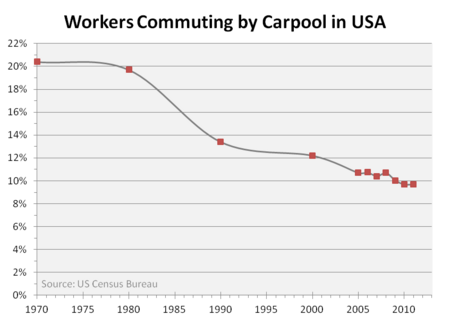Carpool facts for kids
Carpooling means sharing a car ride with other people. Instead of everyone driving their own car, several people travel together in one car. This helps reduce the number of cars on the road.
Sharing a ride can save money for everyone involved. You can split costs like fuel (gas) and tolls (fees to use certain roads). It also makes driving less stressful because you might take turns driving or just relax as a passenger.
Carpooling is also good for the environment. When fewer cars are on the road, there's less air pollution and fewer carbon emissions (gases that contribute to climate change). It also helps reduce traffic jams and the need for lots of parking spaces. Because of these benefits, many cities and governments encourage carpooling.
In 2009, about 43.5% of all trips in the United States involved carpooling. For daily trips to work, about 10% of people carpooled. Most of these carpool trips (over 60%) were with family members. Carpooling is more common in areas with many jobs and where more people live close together.
Contents
How Carpooling Works
Drivers and passengers find each other to arrange shared trips. They can use special websites, apps, or even social media. Once they find a match, they talk about the details. This includes agreeing on costs, where to meet, and if there's space for luggage. Then, they meet up and share the ride as planned.

Carpooling is often used for daily trips to work or school. But it's also becoming popular for longer, one-time journeys. Sometimes, people only join a carpool for part of a long trip. They pay for the distance they travel. This makes carpooling more flexible and helps more people save money.
Many carpooling arrangements are now made through online platforms. These websites or apps help drivers and passengers connect. They often have features like user ratings. This helps build trust within the community, making it safer and easier for everyone.
Encouraging Carpooling
Many companies and local governments have programs to promote carpooling.
One common way governments encourage carpooling is by creating high-occupancy vehicle (HOV) lanes. These are special lanes on roads that only cars with two or more passengers can use. HOV lanes can make carpooling much faster and cheaper, giving people a good reason to share rides. Some places also have special parking spots reserved for carpoolers.
In 2011, an organization called Greenxc started a campaign to encourage carpooling. Their goal was to help people reduce their carbon footprint (the amount of greenhouse gases they produce).
In the United Kingdom, a charity called Carplus promotes carpooling. They work to reduce traffic, parking problems, and air pollution. They also want to encourage new ways of thinking about how people use cars.
However, not all countries support carpooling in the same way. In Hungary, for example, carrying someone for a cost share without a taxi license and paying taxes can be a tax crime. This has led to some people being fined. However, government officials have also said that carpooling should be supported, as long as people are not trying to make untaxed profits from it.
Sharing Travel Costs
Carpooling usually means that everyone in the car, including the driver, shares the travel costs equally. The driver isn't trying to earn money. They are just sharing the cost of a trip they would have made anyway. The main costs to share are fuel and any tolls.
Newer carpooling apps can manage trips in real time using smartphones. They allow drivers to pick up and drop off passengers along their route, not just at the start and end points. These systems can automatically figure out a fair way to share costs. Each passenger pays a fair amount based on how far they traveled and how many people shared the car.
History of Carpooling
Carpooling first became popular in the United States during World War II. It was a way to save gasoline and rubber for the war effort. People formed "car clubs" to share rides. The government even created programs to help people find others to carpool with.
Carpooling became popular again in the mid-1970s because of the 1973 oil crisis and the 1979 energy crisis. During this time, some of the first company vanpools were started at companies like Chrysler and 3M.
However, carpooling declined between the 1970s and the 2000s. In 1970, about 20.4% of US workers carpooled to work. By 2011, this number was down to 9.7%. A big reason for this was that gas prices dropped a lot in the 1980s.
In the 1990s, carpooling was popular among college students because parking on campuses was limited. Later, with the rise of the Internet and then smartphones with GPS, carpooling became much easier to organize. Companies like Zimride (a precursor to Lyft) and later Uber and BlaBlaCar used technology to connect drivers and passengers.
In Europe, long-distance carpooling has grown a lot, especially with services like BlaBlaCar. As of 2020, BlaBlaCar had over 80 million users across Europe and other regions.
In March 2020, Uber and Lyft stopped their carpooling services in the U.S. and Canada. This was done to help control the COVID-19 pandemic by encouraging social distancing.
Carpooling also exists in other forms:
- Slugging is an informal way for strangers to carpool. No money is exchanged, but both the driver and passengers benefit. For example, a driver might need extra passengers to use an HOV lane.
- Flexible carpooling sets up official places where travelers can meet to join carpools.
- Ridesharing companies (like Uber and Lyft) allow people to arrange rides quickly using smartphone apps. Passengers are picked up from their current location.
Challenges with Carpooling
Even with all its benefits, carpooling can have challenges:
- Flexibility: It can be hard to change plans, like making extra stops or changing work times. Some carpooling programs offer "guaranteed rides home" with a taxi company if a carpool plan falls through.
- Reliability: If not enough people use a carpooling network, it might be hard to find a match for a trip. Also, people might not always follow through on their agreed-upon ride. Some online platforms try to fix this by charging passengers when they book, even if they don't show up.
- Riding with strangers: Some people worry about safety when sharing a car with strangers. However, the risk of crime is usually very small. Online carpooling platforms often use reputation systems, where users can rate each other. This helps build trust in the community.
- Overall effectiveness: While many governments support carpooling, some wonder if HOV lanes are always effective. Sometimes, these lanes are empty, which might not help reduce traffic or fuel use as much as intended. For example, in 2012, the Queensland government in Australia ended its carpool lanes because they believed it was causing more traffic.
Some carpooling services use smart technology to find the best matches for users. They can even use real-time traffic data to calculate exact routes and arrival times.
See also
 In Spanish: Vehículo compartido para niños
In Spanish: Vehículo compartido para niños





